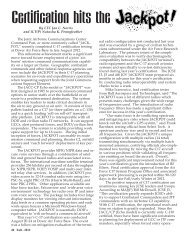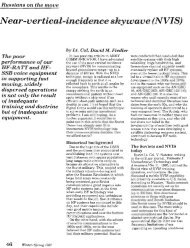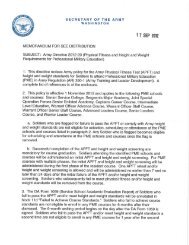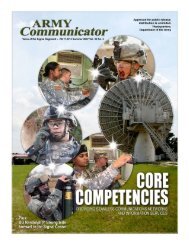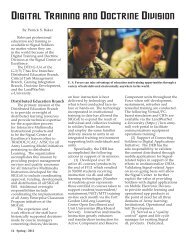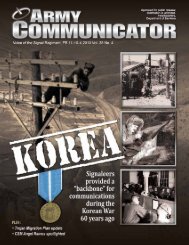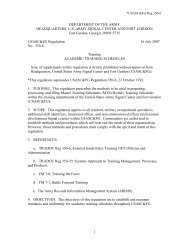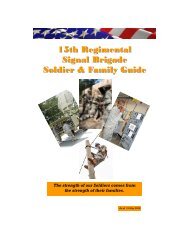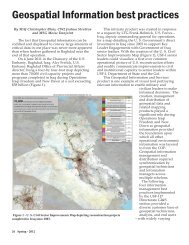AC Summer 08 WIN-T Online - United States Army Signal Center of ...
AC Summer 08 WIN-T Online - United States Army Signal Center of ...
AC Summer 08 WIN-T Online - United States Army Signal Center of ...
You also want an ePaper? Increase the reach of your titles
YUMPU automatically turns print PDFs into web optimized ePapers that Google loves.
ment 1 spirals, along with the<br />
required training and release dates<br />
for present and future spirals.<br />
“I looked at this conference to<br />
help project that for me and then to<br />
have a voice for us to present what<br />
happened to us in theater and what<br />
happened with our training, so we<br />
can help improve the systems to<br />
make it better for the fellow Soldiers<br />
who are going to get the upgraded<br />
spirals and for the future <strong>WIN</strong>-T<br />
program,” he said.<br />
Michael Valdez, the JNN<br />
Fielding Manager who led the efforts<br />
to organize the conference, said that<br />
he has received very positive<br />
feedback on the conference and<br />
requests to be invited next year.<br />
“I have already started initial<br />
planning due to the overwhelming<br />
success <strong>of</strong> this year’s event,” he said.<br />
Heil said that the digital<br />
systems tied to <strong>WIN</strong>-T Increment 1<br />
allowed his commander to make<br />
quicker decisions than he had ever<br />
seen on the battlefield.<br />
During the exercises, the<br />
commander <strong>of</strong> Heil’s unit, used<br />
<strong>Army</strong> Battle Command Systems 6.4’s<br />
capabilities to follow separate<br />
insurgents as they would pass<br />
mortar shells to and from one<br />
another. The unit would circle<br />
around one <strong>of</strong> the insurgents with an<br />
Unmanned Aerial Vehicle, the<br />
Raven unmanned aerial system or<br />
squad level devices. That information<br />
was fed into ABCS 6.4 capabilities.<br />
“We would take those tracks<br />
and he would follow him in,” Heil<br />
said. “We’d send in teams, cordon<br />
<strong>of</strong>f the area or we would bomb that<br />
area at that point.”<br />
During training Heil, who<br />
served as the Brigade Automations<br />
Non-Commissioned Officer-in-<br />
Charge, used a full range <strong>of</strong> digital<br />
systems including the Common<br />
Ground Station, All Source Analysis<br />
System, Digital Topographic Support<br />
System, the Advanced Field<br />
Artillery Tactical Data System and<br />
Maneuver Control Systems-Light.<br />
MCS digitally distributes<br />
tactical information on the battlefield,<br />
allowing a commander to<br />
readily access and display current<br />
Though it was<br />
originally expected to<br />
be fielded in 2013 or<br />
2014, training for the<br />
first <strong>WIN</strong>-T unit is<br />
expected to take place<br />
by 2009.<br />
situation reports, intelligence and<br />
contact reports that assess enemy<br />
strength and movement, as well as<br />
the status <strong>of</strong> friendly forces.<br />
ASAS automates the processing<br />
and analysis <strong>of</strong> intelligence data<br />
from all sources. A commander uses<br />
AFATDS to plan and execute fires<br />
during each phase <strong>of</strong> action including<br />
deliberate attacks or defensive<br />
operations.<br />
CGS is a tactical data processing<br />
and evaluation center that links<br />
multiple air and ground sensors.<br />
DTSS provides digital maps and<br />
updates to commanders and weapons<br />
platforms in support <strong>of</strong> mission<br />
planning and execution.<br />
During the unit’s Joint National<br />
Training <strong>Center</strong> rotation, ABCS 6.4<br />
allowed it to obtain live UAV feeds<br />
that were fed from the common<br />
ground station into AFATDS, Heil<br />
said. This allowed for directional<br />
fire support precisely on the target,<br />
Heil said.<br />
Soldiers from the 1st Brigade<br />
Combat Team/Fourth Infantry<br />
Division preparing for their deployment<br />
to Iraq at the National Training<br />
<strong>Center</strong>, Fort Irwin, Calif., spoke<br />
highly <strong>of</strong> <strong>WIN</strong>-T Increment 1.<br />
The system allows battalions to<br />
communicate and their commanders<br />
to connect to the systems that allow<br />
them to digitally plan the battle<br />
using topographical maps, said SPC<br />
Richard Campbell, a JNN-Network<br />
operator.<br />
It allows units to deploy to and<br />
communicate with any location in<br />
the world, he said.<br />
SSG Michael Irizarry, the unit’s<br />
Ku-trailer operator, said the system<br />
was very reliable during the training<br />
process.<br />
“To operate the system is fairly<br />
easy,” he said. “There are basic<br />
steps to follow. Anyone can really<br />
be trained to operate it within a few<br />
weeks.”<br />
The KU system, he said, can be<br />
set up in about 30 minutes.<br />
“The KU system, with its<br />
capabilities, has given a lot broader<br />
range <strong>of</strong> communications than the<br />
other systems have before,” he said.<br />
“So, it has helped quickly establish<br />
communications within the training<br />
environment.”<br />
Technologically, the <strong>Army</strong>’s<br />
satellite based networks, such as<br />
<strong>WIN</strong>-T Increment 1, has moved the<br />
<strong>Army</strong> to an even playing field with<br />
industry, said 1LT Brian Wilkins, a<br />
Systems Engineer with Florida’s<br />
146th Expeditionary <strong>Signal</strong> Battalion.<br />
“As a whole, industry is using<br />
the same exact stuff,” he said. “It’s<br />
just, we put it into a box and we<br />
send it to the field.”<br />
Internet-based communications<br />
technology also allows for more<br />
modular equipment, where components<br />
can be removed and replaced<br />
with other peripheral pieces, Wilkins<br />
said.<br />
Issues with newer systems can<br />
be resolved with a simple phone call.<br />
When a problem arises with older<br />
systems, Soldiers might need to sift<br />
through old documentation before<br />
taking steps to resolve it. Locating<br />
documentation for systems made in<br />
the 1970s is not an easy task, Wilkins<br />
said.<br />
The transition to <strong>WIN</strong>-T has<br />
generated excitement in the <strong>Army</strong><br />
community, he said.<br />
“We can get away from this<br />
antiquated stuff,” Wilkins said.<br />
“People feel relevant in the world,<br />
when they don’t feel like they are<br />
using stuff that they are never going<br />
to deploy with.”<br />
<strong>WIN</strong>-T Increment 1 was a first<br />
place winner <strong>of</strong> an Institute for<br />
Defense and Government Advancement<br />
2006 Network Centric Warfare<br />
Award under the category <strong>of</strong> Best<br />
Contributions to the Development <strong>of</strong><br />
NCW Theory. Additionally, it was<br />
recognized as one <strong>of</strong> the Top Tech-<br />
<strong>Army</strong> Communicator 35



